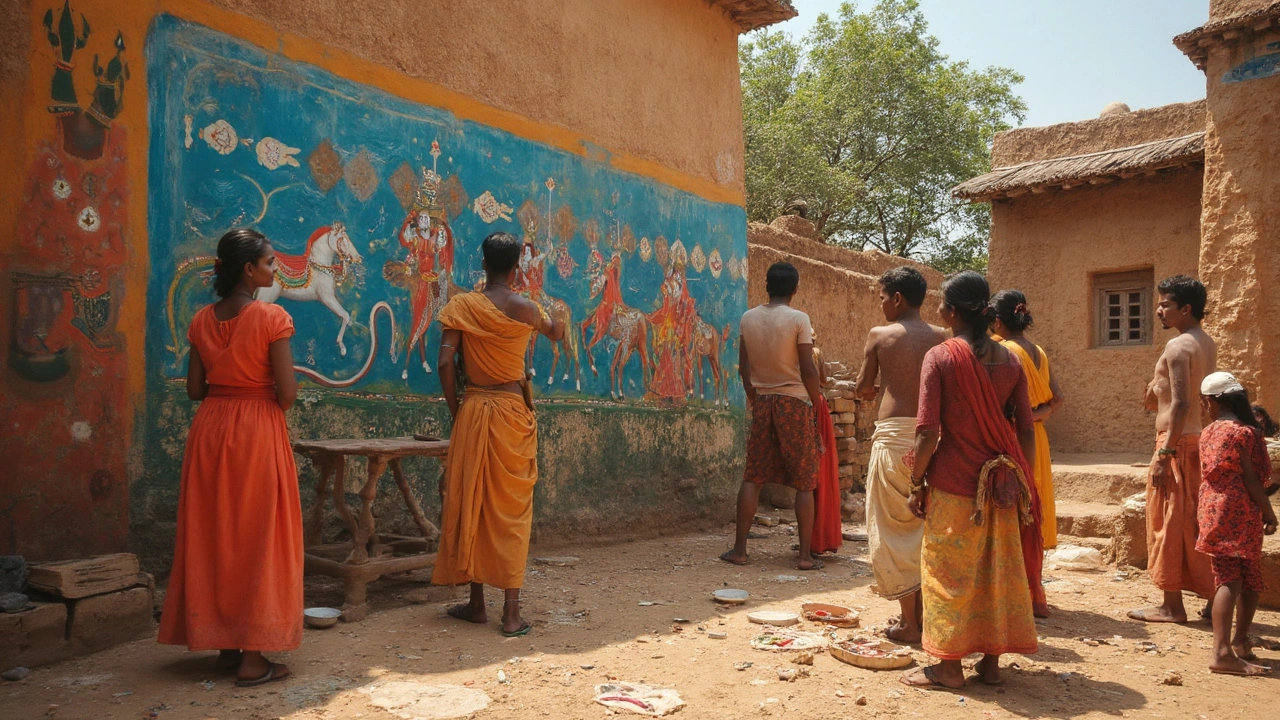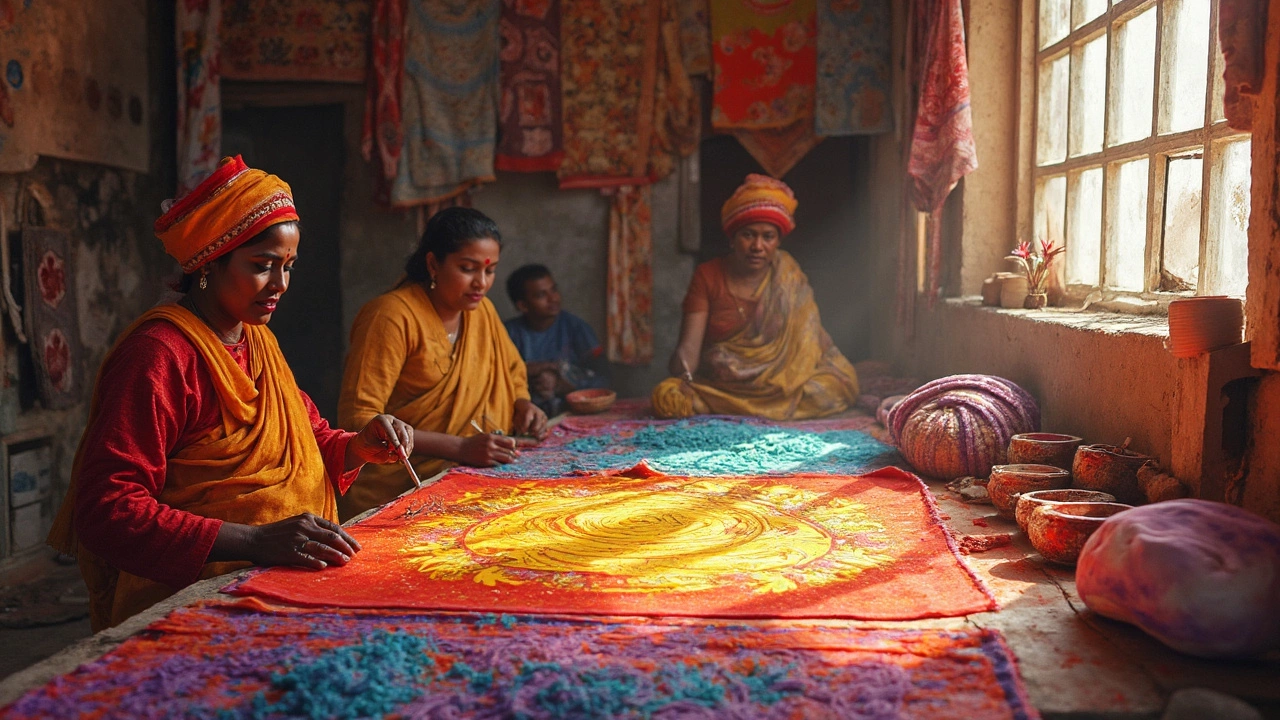What do you picture when you think of Gujarat’s art? Most people guess textiles, but the real superstar is Rogan art. This isn’t your average wall hanging—it’s paint spun from castor oil, twisted with a metal rod, and drawn straight on cloth freehand. There’s no tracing, no stencils. One slip, and the whole piece can be ruined. And here’s the kicker: barely a handful of families in Kutch still know how to do it, with the most famous being the Khatri family in Nirona village.
Rogan paintings aren’t just a cultural showpiece. When Prime Minister Modi gifted Barack Obama a Rogan painting in 2014, it suddenly got the world’s attention. Today, you’ll spot door panels, saree borders, and even notebook covers painted with dazzling ‘Tree of Life’ patterns—all thanks to this craft surviving against the odds.
- Rogan Art: The Signature Style of Gujarat
- Pithora Painting: Stories on Walls
- Other Local Painting Styles You Should Know
- How to Recognise and Buy Authentic Gujarat Art
Rogan Art: The Signature Style of Gujarat
When people talk about the famous painting of Gujarat, Rogan art tops the list. This quirky art form from Kutch isn’t just rare—it’s almost a family secret. Passed down in the Khatri family for over 300 years, there are maybe ten artists left who still practice it.
Wondering what makes Rogan art so unique? Instead of brushes, artists use a metal rod to stretch paint made from boiled castor oil and natural dyes. It’s tricky and honestly, super easy to mess up. The paint never actually touches the rod. Instead, it hangs off in a gooey thread, which the artist barely touches to the fabric, creating insane detail with just a twist of the wrist.
This isn’t just random doodling. Traditional patterns often include the ‘Tree of Life,’ peacocks, or geometric borders—old designs but always with room for the artist’s twist. Each piece can take weeks to finish, depending on size and detail. If you thought paint-by-numbers was hard, imagine doing the entire thing in reverse—left to right with one hand, then folding the fabric to make a mirror image!
- The village of Nirona in Kutch is ground zero for authentic Rogan art.
- A painting by the Khatri family even made it to the White House in 2014 as a gift from India.
- Original Rogan paintings use only natural colors—no shortcuts with synthetics allowed.
| Fact | Details |
|---|---|
| Number of Rogan Artists in Kutch | Fewer than 10 (as of 2024) |
| Main Raw Material | Castor oil (locally grown) |
| Most Common Design | Tree of Life |
If you’re hunting for Gujarat art with a true local vibe, Rogan work is as real as it gets. Try visiting a workshop in Nirona if you can—you’ll see the craft live and understand why it’s so revered. And if you ever get your hands on an original, it’s not just a pretty souvenir. It’s a little piece of living history.
Pithora Painting: Stories on Walls
When you travel through the tribal areas of north Gujarat, it’s hard to miss the huge, colorful murals splashed across people’s living room walls. These are Pithora paintings, and they aren’t just decorations—each is a visual story straight out of local culture and daily life. Made mostly by the Rathwa and Bhil tribes, Pithora art is about giving thanks and marking special moments, like a good harvest or a family celebration.
What makes a Pithora painting stand out? For starters, they never go on a canvas or paper—everything is painted directly on the inside walls of mud houses. Artists start by preparing the wall with two layers of cow dung and mud, which sounds odd but actually helps the colors stick and protects the painting for years. Bright reds, greens, oranges, and blues come next, usually using natural pigments. Whole families often join in, led by male artists called 'Lakhara.'
The designs look lively and busy on purpose. You’ll spot rows of horses (representing the tribal god Baba Pithora), humans, birds, and even scenes showing weddings or hunting. Each figure serves a purpose, either as a blessing, to ward off bad luck, or to say thanks after a wish is granted. If you see a house with a shiny new Pithora mural, it probably means something good just happened in that family.
These days, Pithora paintings have started popping up on canvas and cloth, making them easier to take home as souvenirs. A few tribal artists now give workshops, so if you want a hands-on experience, that’s totally possible too.
| Pithora Painting Key Facts | Details |
|---|---|
| Where is it found? | Panchmahal, Chhota Udaipur, and Dahod districts of Gujarat |
| Who creates it? | Mainly Rathwa and Bhil tribe artists |
| What materials? | Natural colors, mud, cow dung, wall as a surface |
| Main subject | Baba Pithora (tribal deity), horses, village life |
If you’re seeking something truly original from Gujarat, Pithora painting is your go-to. It’s not just a piece of art—it’s a whole story told in colors and symbols, straight from the rooms where people actually live.

Other Local Painting Styles You Should Know
If you think famous painting of Gujarat means just Rogan art, you’d be missing out. Gujarat isn’t a one-trick pony—there’s a lineup of local painting styles you should check out. Each has its vibe, story, and community behind it.
Pithora painting is a big one, especially among the Rathwa and Bhil tribes in the Panchmahal and Chhota Udaipur regions. What makes Pithora art cool is its purpose. People paint it on the inner walls of their houses after a wish comes true. It’s pretty much a painted thank you note to their gods. The scenes are wild and colorful, usually full of horses, riders, and scenes of village life. No sketching first—everything’s straight on the wall from memory.
Then there’s Warli painting. Now, Warli is originally from Maharashtra, but it found its second home in southern Gujarat, especially where the tribes overlap. You’ll spot the trademark stick figures dancing around in circles, all drawn using rice paste on mud walls or brown paper.
Mata ni Pachedi is another standout from the state. This art is kind of Gujarat’s answer to temple tapestries. Artists, mostly from the Vaghari community in Ahmedabad, paint huge fabric hangings—usually in red, black, and white—telling stories of goddess shrines. It’s basically a moving temple for communities that couldn’t enter big temples. Every piece is made by hand, starting with a freehand sketch, then filled in with natural dyes. If you’re into raw, storytelling art, nothing beats Mata ni Pachedi.
"Gujarat’s traditional paintings—whether wall, fabric, or paper—aren’t just decoration. Each brushstroke carries meaning, and the skills have been guarded for over 300 years," says Dr. Hetal Desai, a cultural historian based in Vadodara.
- Pithora paintings: Tribal wall art, done to mark life milestones or fulfill vows.
- Warli art: Simple stick figures, usually celebrating harvest or festivals.
- Mata ni Pachedi: Narrative fabric paintings, heavily detailed, often used during special rituals.
Don’t forget more niche styles like Saurashtra’s Lippan Kaam, where mirrors and mud make up decorative murals. But remember, the core of Gujarat’s Indian handicrafts is always about tradition, storytelling, and vibrant, honest labor. If you ever travel to Gujarat, local markets are packed with these treasures, often directly from the artists themselves.
How to Recognise and Buy Authentic Gujarat Art
So, you’ve spotted a famous painting of Gujarat online or in a market and you’re wondering, is it the real deal or a cheap knockoff? Here’s how to figure it out without falling for tourist traps.
First, check the details. Rogan art should have razor-sharp lines and the paint will almost look raised from the cloth. Real Rogan pieces are made with natural castor oil paint—run your finger lightly over it (ask before you touch!) and you’ll feel a texture that machine prints just can’t copy. If the artwork looks printed, too perfect, or you see repeating patterns, it’s probably not hand-made.
With Pithora paintings, pay attention to the materials. Authentic ones use natural dyes, and you’ll see minor imperfections because they’re painted directly on mud walls or thick paper, not smooth canvas. The colors are super vibrant but not glossy, and the images usually have scenes of horses, ancestors, or rituals, often in crowded frames.
When buying, stick to trusted sources. Here’s where to look:
- Government emporiums: Like Gujarat State Handloom & Handicrafts Development Corporation (Garvi Gurjari), they guarantee original art and fair pay for artists.
- Artisan villages: Nirona for Rogan art (ask for the Khatri family), or visit tribal regions like Chhota Udepur for Pithora paintings. Many families open their homes as workshops.
- Craft fairs: The Rann Utsav in Kutch and Surajkund Mela in Haryana draw real artists, not middlemen.
- Online certified portals: Websites like gaatha.com, craftsvilla.com, and direct artist pages on Instagram—look for places with artist bios, not just slick product shots.
If you want to compare before you buy, here’s a quick cheat sheet:
| Art Type | What to Check | Red Flags |
|---|---|---|
| Rogan Art | Raised paint, unique lines, artist signature | Printed patterns, flat texture, no family name mentioned |
| Pithora Painting | Natural dyes, uneven brushwork, symbolic figures | Glossy finish, perfect lines, sold as wall stickers |
Last tip—authentic Gujarat art usually comes with a story. A real artist or seller will be happy to tell you how it was made, who made it, and why. If you hear generic answers or they dodge your questions, walk away and hunt elsewhere.
